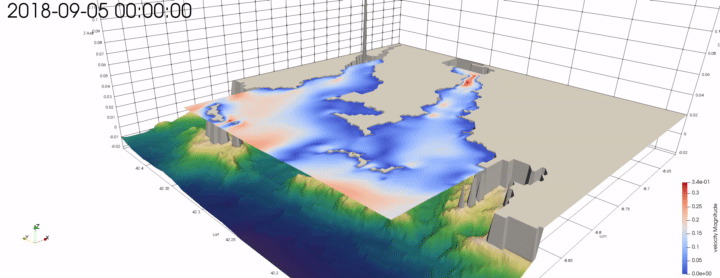MOHID Lagrangian
 3D passive tracers using currents from a MOHID operational application in Vigo coastal area, Galicia, Spain.
3D passive tracers using currents from a MOHID operational application in Vigo coastal area, Galicia, Spain.
MOHID Lagrangian is a comprehensive high-performance Lagrangian tracer model that can perform as library for the MOHID Water Modelling System or as a standalone program.
The library implements the necessary tools to generate a comprehensive Lagrangian tracer model, with sources, sinks, particle types and several options for forcing and Inputs/Outputs.
The MOHID Lagrangian is a specific implementation of the library, designed as a post-processing or online tool, ready to be forced with other results from other circulation models.
The MOHID Lagrangian include among its characteristics:
- Multi-threaded code, designed for shared memory machines;
- Robust pre-processing, modelling and post-processing tools;
- Cross-platform compliant, tested and deployed;
- Cmake based project, easy to set up for local compilation if required;
- Ability to model passive, buoyant and degrading tracers;
- Ability to model millions of tracers in a modest laptop machine;
- Simple and fully documented simulation set-up files, ready to be abstracted by a User Interface;
- Documentation on installation, code structure, case preparation, post processing and general usage. Fully self-contained examples to get you started.
 Floating passive tracers on a CMEMS Atlantic currents solution.
Floating passive tracers on a CMEMS Atlantic currents solution.
Main features | |
|---|---|
| Inputs |
|
| Solvers | Provides 1st, 2nd and 4th order integrators. |
| Sources |
|
| Outputs |
|
Main Processes | |
|---|---|
| Tracers |
Tracers are just basic tracers (pure Lagrangian)+ ’stuff’ Always 3D entities |
| Processes |
|
For more information check the MOHID Lagrangian Installation Guide and the Short User Guide
The first version of this model was developed during the CleanAtlantic project (EAPA_165/2016)
funded by INTERREG Atlantic Area programme
funded by INTERREG Atlantic Area programme





